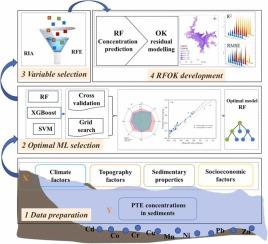A feature selection-based hybrid model for accurate spatial prediction of potentially toxic elements in sediments: Application to Poyang Lake, China
IF 11.3
1区 环境科学与生态学
Q1 ENGINEERING, ENVIRONMENTAL
引用次数: 0
Abstract
Accurately predicting spatial distribution of potentially toxic elements (PTEs) in sediments is crucial for protecting aquatic ecosystem but remains challenging due to complex interactions of environmental variables. This study developed an integrated framework by combining optimal machine learning (ML) with ordinary kriging (OK) and feature selection to improve prediction accuracy of PTEs in Poyang Lake sediments. Three ML models—random forest (RF), extreme gradient boosting (XGBoost), and support vector machine (SVM)—were evaluated to identify the optimal approach for predicting PTE concentrations. Feature selection techniques including relative importance analysis and recursive feature elimination were applied to identify suitable predictors for each PTE. RF model outperformed the others across all PTEs (R2>0.70). Distinct sets of predictors were identified for each PTE, further refining RFOK model. Incorporating selected predictors, RFOK significantly enhanced prediction accuracy, increasing R2 by 37.5% (Cr) to 421% (Cd) relative to OK, and by 133% (Cr) to 457% (Pb) relative to inverse distance weighting, effectively capturing fine-scale spatial variability. The findings highlight the effectiveness of the RFOK hybridization and the importance of feature selection in enhancing prediction accuracy within complex multifactor aquatic environments, providing scientific supports for designing targeted protection strategies against PTE pollution in aquatic ecosystem.

基于特征选择的沉积物中潜在有毒元素空间准确预测混合模型——以鄱阳湖为例
准确预测沉积物中潜在有毒元素(pte)的空间分布对保护水生生态系统至关重要,但由于环境变量的复杂相互作用,仍然具有挑战性。本研究将最优机器学习(ML)与普通克里格法(OK)和特征选择相结合,建立了一个集成框架,以提高鄱阳湖沉积物pte的预测精度。对随机森林(RF)、极端梯度增强(XGBoost)和支持向量机(SVM)三种ML模型进行了评估,以确定预测PTE浓度的最佳方法。包括相对重要性分析和递归特征消除在内的特征选择技术被用于识别每个PTE的合适预测因子。RF模型在所有PTE中表现优于其他模型(R2>0.70)。为每个PTE确定了不同的预测因子集,进一步完善了RFOK模型。结合选定的预测因子,RFOK显著提高了预测精度,相对于OK, R2提高了37.5% (Cr)至421% (Cd),相对于逆距离加权,R2提高了133% (Cr)至457% (Pb),有效地捕获了精细尺度的空间变异性。研究结果突出了RFOK杂交的有效性和特征选择对提高复杂多因素水生环境下PTE污染预测精度的重要性,为设计针对性的水生生态系统PTE污染保护策略提供了科学支持。
本文章由计算机程序翻译,如有差异,请以英文原文为准。
求助全文
约1分钟内获得全文
求助全文
来源期刊

Journal of Hazardous Materials
工程技术-工程:环境
CiteScore
25.40
自引率
5.90%
发文量
3059
审稿时长
58 days
期刊介绍:
The Journal of Hazardous Materials serves as a global platform for promoting cutting-edge research in the field of Environmental Science and Engineering. Our publication features a wide range of articles, including full-length research papers, review articles, and perspectives, with the aim of enhancing our understanding of the dangers and risks associated with various materials concerning public health and the environment. It is important to note that the term "environmental contaminants" refers specifically to substances that pose hazardous effects through contamination, while excluding those that do not have such impacts on the environment or human health. Moreover, we emphasize the distinction between wastes and hazardous materials in order to provide further clarity on the scope of the journal. We have a keen interest in exploring specific compounds and microbial agents that have adverse effects on the environment.
 求助内容:
求助内容: 应助结果提醒方式:
应助结果提醒方式:


